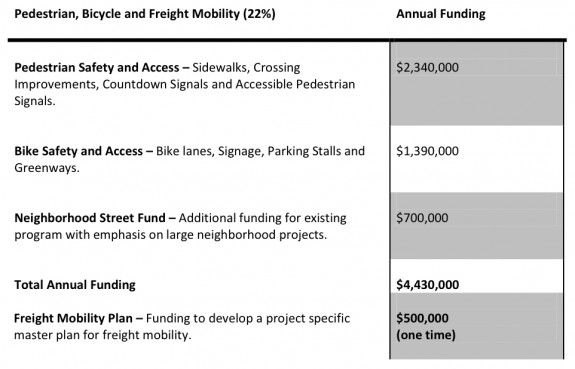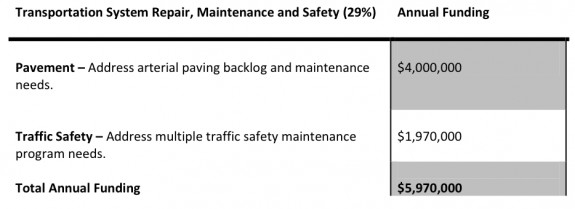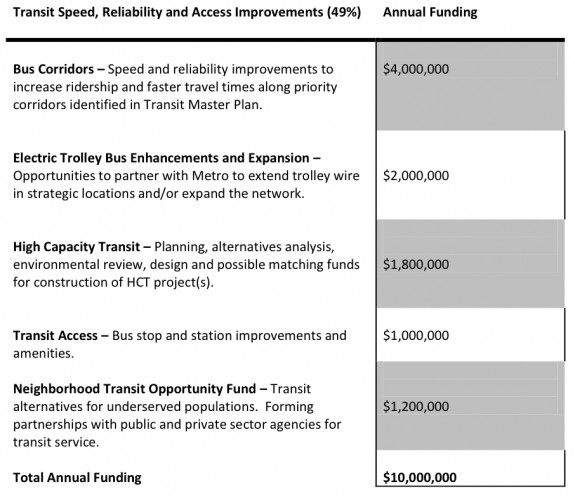The City Council, acting as the Transportation Benefits District, voted unanimously to send a $60 vehicle license fee to the November ballot. It’s not the full $80 recommended by the Citizens Transportation Advisory Committee (CTAC III), but the funding allocations are mostly proportional to the committee’s recommendations.
The funds are more about transit than bicycling, but passing the funds would be a significant 10-year investment in positive, effective transportation in Seattle. It’s now time to work on painting a clear and inspiring picture for why people should vote for this funding.
 The plan would put an annual $1.3 million into bicycle-specific safety and access projects, including neighborhood greenways, bike lanes, parking, etc.
The plan would put an annual $1.3 million into bicycle-specific safety and access projects, including neighborhood greenways, bike lanes, parking, etc.
 However, the funds would also spend $2.3 million on pedestrian specific projects and $6 million on paving and traffic safety, all of which could have some overlap with bicycle safety, complete streets and access.
However, the funds would also spend $2.3 million on pedestrian specific projects and $6 million on paving and traffic safety, all of which could have some overlap with bicycle safety, complete streets and access.
$500,000 would go to creating a new Freight Master Plan.
 The largest chunk, however, would go to transit and providing funding for the under-construction Transit Master Plan. $10 million annually would be used to complete reliability and speed for transit, expanding the electric trolley infrastructure and planning high capacity transit (e.g. more streetcars).
The largest chunk, however, would go to transit and providing funding for the under-construction Transit Master Plan. $10 million annually would be used to complete reliability and speed for transit, expanding the electric trolley infrastructure and planning high capacity transit (e.g. more streetcars).
First, let’s be clear that this fee is not about bicycle projects. I have noticed an increase in the “let’s license bicycles” line since this debate started, which is really unfortunate (I will have a “why bicycle licenses make no sense” post soon). But with this fee, the two-wheeled are clearly the lowest on the totem pole.
The creation of a Freight Master Plan has the potential to conflict with the Bicycle Master Plan, an update for which has already been delayed due to its consistent lack of funding. What happens if a needed bicycle project happens to be on a route designated in the FMP? It just so happens that many of the roads most in need of safe bicycle facilities are also used by industry. How will these potential differences be hashed out? It’s not necessarily a bad thing to have freight needs mapped out, and maybe it could be designed as a good way to make sure all needs are met without unnecessary fighting and name-calling. But without a clear idea of how that would work, it’s hard to think of this as overly-positive for people hoping for safer bicycle routes.
Another major component of this project is expansion of the streetcar network. Again, people who ride bicycles in Seattle would not be crazy to have serious doubts about expanding the streetcar system. The only example we have on the ground is a terrible, dangerous streetcar that has hurt a lot of people and has made riding a bicycle in South Lake Union extremely difficult and confusing. The more bike-friendly (though not perfect) approach by the First Hill Streetcar is promising, but people who ride bikes might need a very convincing argument before they get too excited about more streetcars.
Between those who think the SLU Streetcar is useless and those who think it’s dangerous, forking over an extra $60 per motor vehicle per year for a large expansion of the system might be a tough sell.
But this transportation funding measure is good. It is not the game-changing investment in bicycle infrastructure our city needs to dramatically increase ridership and invest in truly innovative bicycle facilities, but it is a solid, annual increase in funding for the Bicycle Master Plan and safer streets for everyone.
It’s also a gutsy proposal by transit advocates for projects that could change the face of the city. Even though transit is the top means of transportation for commuters to downtown Seattle, it is going to take even wider support than that to pass these funds. With the passage of the deep bore tunnel referendum and its astronomical investment in motor vehicle travel, Seattle needs to pass a measure that makes a long-term investment in the future we want to see in our city.
Transit advocates, City Councilmembers and Mayor McGinn, it’s up to you to put forth a vision of what these funds will buy our city. We need to be sold on streetcars. Perhaps more importantly, we need to know how and why investments can help make buses run faster and more reliably. We need to know what dirty diesel buses might be able to be put on trolley wires, making our streets quieter and, importantly for people riding bikes, our air cleaner.
People of Seattle share a hope for a cleaner, safer city that easier to move around in, but they aren’t going to fork over hard-earned cash unless they can be convinced they are actually investing to make that happen.








Comments
10 responses to “Set for November vote, $60 vehicle fee needs strong vision”
Thanks for this article. In the wake of the tunnel referendum, it’s nice to remember that some potentially good stuff happened yesterday. I’m cautiously optimistic about the freight mobility plan. Getting freight to Ballard has been one of the more dubious claims of the tunnel supporters. I suspect more freight moves across the Ballard Bridge than the Aurora Bridge. In spite of the historically antagonistic relationship between industry and bicyclists, I’m hopeful that this could be a step toward recognizing that both sides have valid and socially useful needs.
I share your concerns about streetcars. South Lake Union was a disaster. First Hill looks good (or at least acceptable) on paper, but I’d like to see the implementation before I count myself as a streetcar supporter.
Paving and traffic safety improvements potentially benefit us all: bicycles, cars, and transit. I’ve got several rough patches on my daily commute. Would be nice to see some of these fixed.
I’ve been bicycling around Seattle for nearly 40 years now. In the 70s we had no bicycle infrastructure to speak of, but we managed to get around. I appreciate the support we get from the city, but short of gross mistakes (SLUT), this has always been a good city in which to bike.
Just to be clear (or, color me Stupid), this license fee is separate and distinct from the $20 surcharge adopted by the Council the other day for preservation of existing transit?
The ballot item will be an interesting diagnostic on whether the “we all get free lunch” fad promoted by Eyman et al remains popular.
I’m an avid biker and I (we) all stand to benefit from this. But I don’t support this measure at all. More bloated tax crap thrown at us. I refuse to let my “myopic” view distort the economic realities we are facing. Speaking of which, why is it costing almost 6 million dollars to repair a 2 mile stretch of the BG in Lake Forrest Park? Oh I’ll love it when it’s done, but it’s a perfect example of our system broken and the waste that goes on. I could have EASILY lived with that stretch of trail the way it was.
Maybe you personally could have lived with it, but thousands of people a day use the Burke-Gilman and it’s King County’s job to safely maintain it. The trail suffered from repeated mudslides that the County has to clean up, it was overdue for new pavement, it was too narrow and overcrowded, and it didn’t meet federal standards.
Todd, details on the BG project may be found here:
http://www.kingcounty.gov/operations/capitalImprovements/parkscip/projects/burkegilmantrail.aspx
http://www.kingcounty.gov/operations/capitalImprovements/parkscip/projects/burkegilmantrail/documents.aspx
Voters approved this project as part of a levy:
“This redevelopment project is expected to cost $2.69 million and is being funded by the voter-approved 2008–2013 Parks Expansion Levy. These funds are dedicated exclusively to regional trail development and open space acquisition in King County.”
The approach taken to the improvements reflects long term thinking, not simply grinding down some roots and throwing down a few shovels of asphalt. Apparently most voters believe in this sort of wisdom, judging from the approval shown the levy in balloting.
It’s worth noting that the project costs less than half the figure cited by Todd.
I stand corrected and thank you Doug. I apologize for stating the facts incorrectly. I was misinformed. My bad. And I understand the will of the people and I’m VERY happy this is going to be done. I will directly benefit from it. Still, 2.69 million dollars for 2 miles? Really?? That’s acceptable to you? I did read those links before and found nothing in there that justifies this figure — even the 2.69 million one. Nothing.
Actually, I stand corrected. I knew about the wetland issue, drainage improvements, the walls, the bridge, and the widening of the trail. But my original, erroneous, and overstated cost — corrected by Doug — cut in half is much more easier to swallow because I missed something critical in the plans: The trail is going to be illuminated through this stretch. That’s right. Lights! With this info, this number seems much more feasible. I’m sure there’s plenty of grafting going on, but this considerably softens my abrasion to the project.
Digging through project documents reveals an almost fractal explosion of details, addressing most of which ends up with extensive use of tools. I agree the number seems on the face of it breathtaking but at the same time the planners seem determined not to cut corners that would just leave more problems to be solved in the future, more expensively.
For me it always helps to amortize big numbers. Estimates of daily usage of this section of trail are from 1000-1500 individuals per day, so taking 1250 as a likely figure that gives us a little over 450,000 uses per year. Assuming the trail exists for another 20 years, that’s $0.29/use of these improvements. Admittedly that’s a pretty rough calculation but it does tell us that the costs being incurred here are not too horrible, compared to a fully paid bus trip for instance. One could go large with the calculation and factor in what acquiring such a right-of-way would cost today; things look positively rosy when we take into account the total magnitude of the BG gift compared to the price of optimizing it.
This is a great discussion on the BG Trail. Oddly, it found it’s way under this blog. :)
[…] 1 spending. Bicycle, pedestrian and freight improvements combined make up only 22 percent of the total proposed funding. This bill is very good for bicycle access and road safety for all users, but it’s also much […]